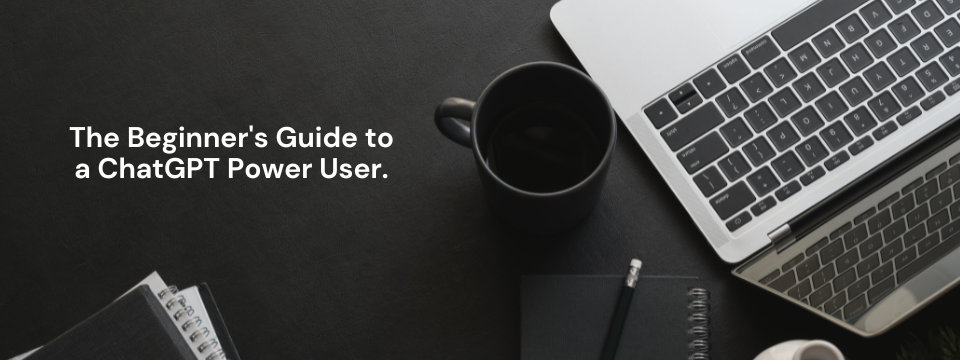The Beginner's Guide to a ChatGPT Power User

The integration of AI into our daily routines is no longer a futuristic concept but a practical reality that can significantly enhance productivity and creativity. ChatGPT, as a leading conversational AI, offers a myriad of capabilities that can transform the way we approach various tasks. In this blog post, we'll explore practical tips and case studies on how to become a ChatGPT power user, leveraging its capabilities to optimize your work and unlock new possibilities.Read more.

The Essence of Effective Prompting
At the heart of leveraging ChatGPT is the ability to create effective prompts that yield precise and useful responses. Here's how to refine your prompting skills:
Prompting for Creativity
If you're looking for imaginative responses, explicitly ask ChatGPT to "brainstorm" or "think creatively." Encourage the AI to explore unconventional ideas by instructing it to generate "out-of-the-box" solutions.
Rephrasing for Clarity
If ChatGPT struggles to provide a satisfactory answer, consider rephrasing your question or providing more context. Sometimes, a minor adjustment in wording can lead to more accurate and relevant responses. Remember, it's a conversation—you can continue to provide information to get the best possible answer.
Utilizing System Messages
System messages allow you to guide AI behavior during the conversation. By providing advanced instructions through system messages, you can direct the conversation towards a specific tone or style, ensuring consistency in the generated responses.
Example Prompt:
"Please provide a detailed analysis of the impact of AI on the job market, focusing on both positive and negative aspects. Use a balanced and informative tone."
ChatGPT Tools
Helps users craft perfect prompts for AI chatbots. It rewrites entire prompts to make them highly detailed, aiding ChatGPT in developing informative and specific responses.
Zapier
Allows users to interact with over 5000 different work applications without additional steps. It enables users to draft emails or send in-depth Slack messages from ChatGPT.
XXAI
Enables users to generate images within software using ChatGPT's models. Users describe the desired image, and the system generates it.
Custom Commands: Tailoring AI to Your Needs
Custom Commands represent a significant advancement, allowing users to set preferences that AI considers in its responses:
Customization
Application: Tailor responses to industry-specific needs or personal preferences.
Example: Setting up preferences for project management methodologies or data presentation formats.
Efficiency
Benefit: Eliminates repetitive statements of preferences in conversations.
Implementation: Once set, consistently applied across all interactions.
Plugin Enhancement
Integration: Shares relevant information to improve plugin interactions.
Example: Specifying target audiences for market research plugins.
Formatting Output for Enhanced Readability
ChatGPT excels at generating text, but sometimes including tables or HTML in blog posts can be beneficial. You can specify various formats for your query output.
Descriptive Data Visualization
ChatGPT can be used to describe complex data visualizations. By providing data about charts or graphs, ChatGPT can generate comprehensive visualization descriptions. This can help present complex data to stakeholders in a more understandable format, aiding the decision-making process.
HTML Generation
ChatGPT can generate HTML code based on user requests. This is an effective way to quickly create web content or generate boilerplate code for web development. The output can be formatted with syntax highlighting, making it easier to read and debug.
Tabular Data Presentation
ChatGPT can present data in tabular format. By inputting raw data, ChatGPT can generate well-structured tables, making data easier to read and analyze. This can be particularly useful when presenting business reports or statistical data. You can use browser extensions like Table Capture to copy them into spreadsheets.
Case Study: Enhancing Academic Research
One of the significant benefits of ChatGPT is its ability to assist in academic research. Researchers can use ChatGPT to streamline their literature review process, identify reference gaps, and even aid in writing academic papers.
Literature Review Workflow
By using semantic search with AI, researchers can obtain a comprehensive reading list on any literature review topic in under a minute. This AI search is a paradigm shift for literature reviews, allowing researchers to find papers that contain solutions to their research questions.
Finding Gaps in the Literature
Researchers can use tools like the Litmaps App to identify what papers the authors could have cited but didn't. This process takes less than a minute and can be applied to unpublished papers as well, ensuring no important references are missed.
AI-Augmented Academic Writing
AI can teach scientific writing, find missing citations, structure manuscripts, and identify logical gaps in papers. This can significantly improve the quality of writing and smoothen the path to publication.
Conclusion
Mastering ChatGPT is about more than just using it as a tool; it's about integrating it into your workflow as a strategic partner. From crafting precise prompts to utilizing plugins and custom commands, the path to becoming a power user is one of continuous learning and adaptation. With the projected growth in the plugin ecosystem and the ongoing development of features like Custom Commands, the future of AI-assisted productivity looks promising. Embrace these advancements to stay ahead in your field and unlock new dimensions of efficiency and creativity.
Note: This blog post has been crafted to provide a comprehensive understanding of ChatGPT's capabilities, with a focus on practical application and strategic use. The numbers and examples provided are illustrative and based on the current capabilities of ChatGPT and its ecosystem.